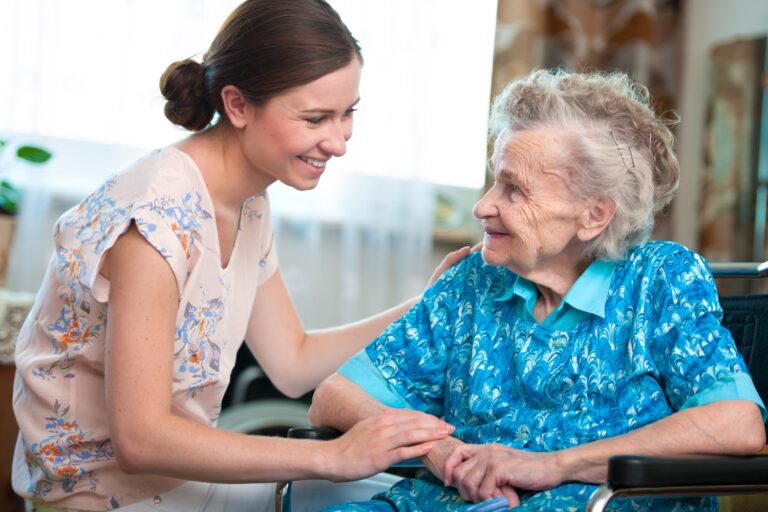Given that nearly 90% of seniors say they prefer to age independently in their own homes rather than make the transition into assisted living facilities, live-in caregivers are becoming an increasingly popular home care option.
They are essential for clients with mid to late-stage dementia or physical limitations that make it impossible for them to live safely and independently in their homes.
How Does Live-In Care Work?
Live-in caregivers work in different ways, depending on the home care agency policies and the caregivers’ availability.
Live-In Caregiver Meaning vs. 24-Hour Care
Live-in care is different from 24-hour care. Live-in caregivers get a designated room for their things and live in the home with their clients. They also sleep at the house (more on that below) but are required to support clients with basic needs at night, such as safe transfers and support going to the bathroom or getting a drink of water.
That is different from 24-hour care, where caregivers provide caregiving services around the clock—usually divided into three 8-hour shifts. With 24-hour care, the caregivers are entitled to breaks and meals but are awake for the entirety of their shift so they can support clients during every minute of their shift.
Live-In Caregiver Services
There are no set duties performed by live-in caregivers. Rather, caregivers are there to provide all of the services offered by our agency, but that will fluctuate from day to day based on a client’s needs. All services are included in the flat-rate fees for live-in care services.
Most clients requesting live-in caregiver support need the following:
- Companionship
- Personal care services
- Errand and grocery services
- Meal planning and preparation
- Medication reminders
- Light housekeeping
- Laundry and linen changes
- Support getting to/from medical appointments
- Company on outings, for events, or to enjoy seasonal activities
- Pet care
- Gardening or basic yard work (no heavy labor unless the caregiver enjoys it)
- And more
Again, these services are tailored to the client’s needs.
Working As a Solo Live-In Caregiver
In this scenario, one caregiver moves into the home and must have their own bedroom and a closet or dresser to store their belongings. Solo live-in caregivers typically work five days a week with two days off. They are also entitled to a four-hour break during the day.
The model of live-in care is designed such that caregivers are actively “on” or working for about 10 hours a day but are still “on-call” during the other hours to support clients here and there.
Depending on the client’s needs and abilities, family or respite caregivers may be called to fill in when the live-in caregiver is off duty. These caregivers are entitled to 8-hours of sleep each night, knowing they must be able to wake up and support the client if needed.
Night-time support would be very simple and would entail handling relatively easy-to-accommodate needs like getting to/from the bathroom, providing a drink of water, or administering medications.
If needs move beyond that, 24-hour or overnight caregiving services are a better option, ensuring caregivers are awake during the night shift to support more challenging or time-consuming needs.
Working As a Team of Live-In Caregivers
In this scenario, two or three caregivers switch off living with the clients for anywhere from three to five days at a time. In some cases, they have their own vehicle and use it to provide transportation services. Other caregivers may rely on public transportation to get to/from the client’s home and to run errands or accompany the client to appointments or on outings.
With the team-oriented model, two or three caregivers switch off every few days, ensuring the client has non-stop supervision and care while also accommodating the caregivers’ needs, transportation availability, and family schedules.
Live-in Caregiver Meaning = Patience
If you’re considering a job as a live-in caregiver, we feel obliged to say that the live-in caregiver meaning or definition is synonymous with patience. Yes, all caregivers should have compassion and patience, but live-in caregivers need even more.
In most cases, clients requiring live-in care have Alzheimer’s or another dementia-related condition that negatively impacts their memory and their sense of time and place. In other cases, clients have mobility issues that put them at risk of falling, making it unsafe to navigate their homes without assistance.
In either scenario, the odds are good that your sleep will be interrupted from time to time. While you are able to make yourself at home in their houses to a point, your main role is to provide support for all aspects of the client’s safety, care, and well-being.
This isn’t always easy and it takes a special person—with a special calling to serve others—for the position to benefit the clients, their families, and our caregivers.
That said, if the client’s needs exceed more than the occasional call for assistance during the night, the Georgetown Home Care team is here for you. We trust our caregivers’ input, and if the client’s needs exceed what live-in care is supposed to provide, we will work with the client and their family to establish 24-hour home care.
Do You Have What It Takes to Be a Live-In Caregiver?
Do you feel called to help others as a live-in caregiver? Georgetown Home Care would love to meet you and learn more about your experience.
If you don’t have professional caregiver experience just yet, that’s okay. Your compassionate heart, dependability, and commitment to the work are significant first steps. We provide education, training, and continuing growth opportunities to all our caregivers, empowering them to provide the highest quality care to clients and families.
Our caregivers are the cream of the crop. They are committed, highly qualified, dependable, and extraordinarily caring of others. Does that sound like you? Apply today and learn more about what it means to be a part of the Georgetown Home Care team.

